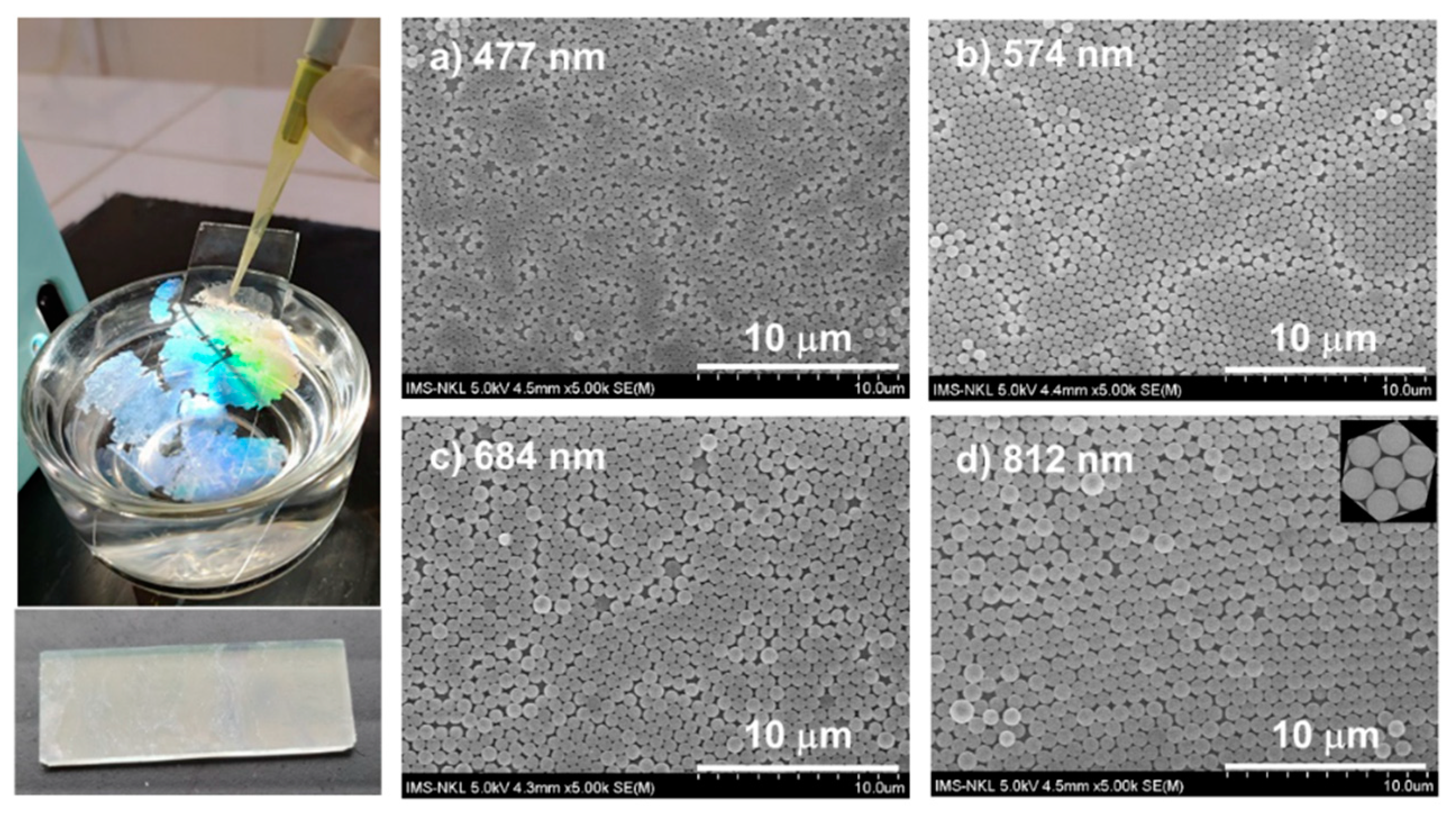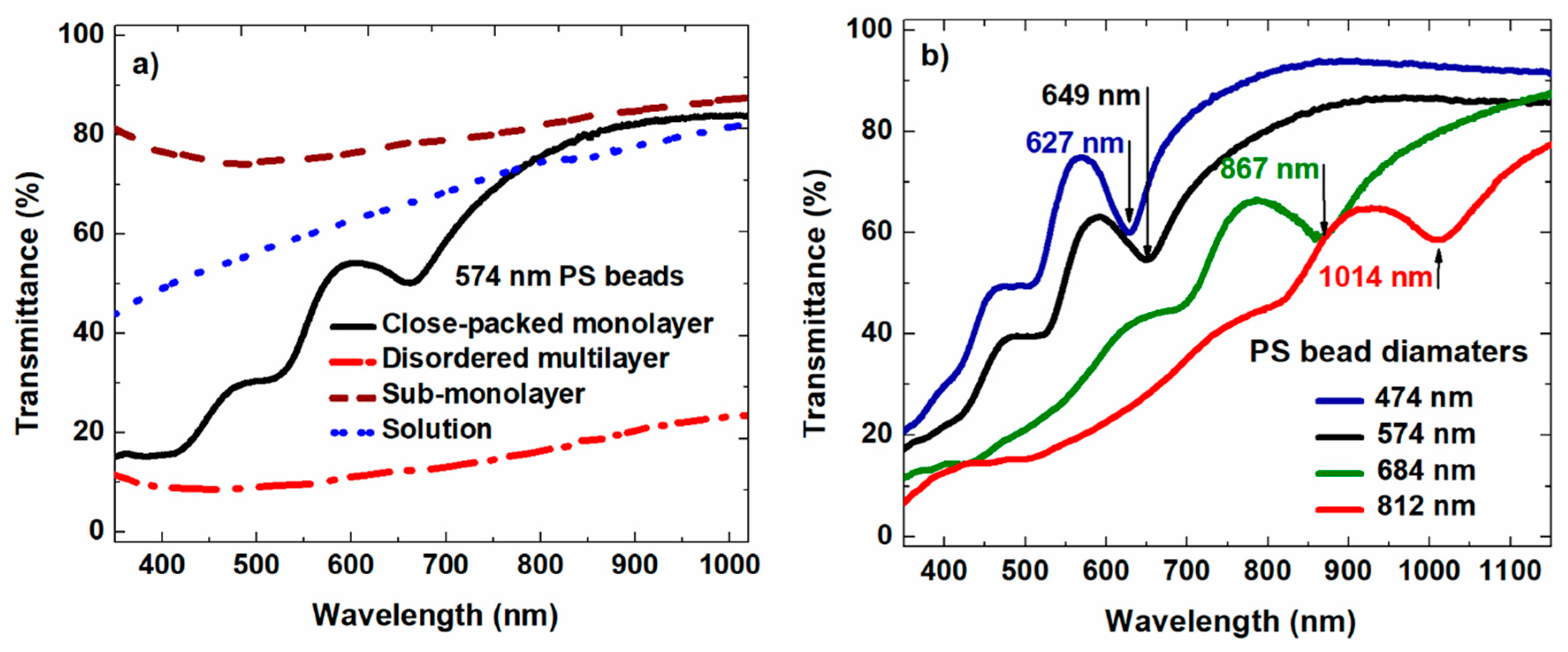Size Determination of Polystyrene Sub-Microspheres Using Transmission Spectroscopy
Abstract
:Featured Application
Abstract
1. Introduction
2. Materials and Methods
3. Results
3.1. Experimental Results
3.2. Simulation
4. Discussion
5. Conclusions
Author Contributions
Funding
Conflicts of Interest
References
- Vanderhoff, J.W.; El-Aasser, M.S.; Kornfeld, D.M.; Micale, F.J.; Sudol, E.D.; Tseng, C.-M.; Sheu, H.-R. The First Products Made in Space: Monodisperse Latex Particles. MRS Online Proc. Libr. Arch. 1986, 87, 213. [Google Scholar] [CrossRef] [Green Version]
- Alfrey, T.; Bradford, E.B.; Vanderhoff, J.W.; Oster, G. Optical Properties of Uniform Particle-Size Latexes*. J. Opt. Soc. Am. 1954, 44, 603. [Google Scholar] [CrossRef]
- Shao, J.; Zhang, Y.; Fu, G.; Zhou, L.; Fan, Q. Preparation of monodispersed polystyrene microspheres and self-assembly of photonic crystals for structural colors on polyester fabrics. J. Text. Inst. 2014, 105, 938–943. [Google Scholar] [CrossRef]
- Sekerak, N.M.; Hutchins, K.M.; Luo, B.; Kang, J.G.; Braun, P.V.; Chen, Q.; Moore, J.S. Size control of cross-linked carboxy-functionalized polystyrene particles: Four orders of magnitude of dimensional versatility. Eur. Polym. J. 2018, 101, 202–210. [Google Scholar] [CrossRef]
- Lee, J.; Ha, J.U.; Choe, S.; Lee, C.S.; Shim, S.E. Synthesis of highly monodisperse polystyrene microspheres via dispersion polymerization using an amphoteric initiator. J. Colloid Interface Sci. 2006, 298, 663–671. [Google Scholar] [CrossRef] [PubMed]
- Chandler, W.L.; Yeung, W.; Tait, J.F. A new microparticle size calibration standard for use in measuring smaller microparticles using a new flow cytometer. J. Thromb. Haemost. 2011, 9, 1216–1224. [Google Scholar] [CrossRef]
- Kaur, H.; Kumar, S.; Kukkar, D.; Kaur, I.; Singh, K.; Bharadwaj, L.M. Transportation of Drug-(Polystyrene Bead) Conjugate by Actomyosin Motor System. J. Biomed. Nanotechnol. 2010, 6, 279–286. [Google Scholar] [CrossRef]
- Rozynek, Z.; Bielas, R.; Józefczak, A. Efficient formation of oil-in-oil Pickering emulsions with narrow size distributions by using electric fields. Soft Matter 2018, 14, 5140–5149. [Google Scholar] [CrossRef]
- Kubiak, T.; Banaszak, J.; Józefczak, A.; Rozynek, Z. Direction-Specific Release from Capsules with Homogeneous or Janus Shells Using an Ultrasound Approach. ACS Appl. Mater. Interfaces 2020, 12, 15810–15822. [Google Scholar] [CrossRef]
- Mikkelsen, A.; Kertmen, A.; Khobaib, K.; Rajňák, M.; Kurimský, J.; Rozynek, Z. Assembly of 1D Granular Structures from Sulfonated Polystyrene Microparticles. Materials 2017, 10, 1212. [Google Scholar] [CrossRef] [Green Version]
- Mikkelsen, A.; Khobaib, K.; Eriksen, F.K.; Måløy, K.J.; Rozynek, Z. Particle-covered drops in electric fields: Drop deformation and surface particle organization. Soft Matter 2018, 14, 5442–5451. [Google Scholar] [CrossRef] [PubMed] [Green Version]
- Fernandez-Bravo, A.; Yao, K.; Barnard, E.S.; Borys, N.J.; Levy, E.S.; Tian, B.; Tajon, C.A.; Moretti, L.; Altoe, M.V.; Aloni, S.; et al. Continuous-wave upconverting nanoparticle microlasers. Nat. Nanotechnol. 2018, 13, 572–577. [Google Scholar] [CrossRef] [Green Version]
- Heifetz, A.; Kong, S.-C.; Sahakian, A.V.; Taflove, A.; Backman, V. Photonic Nanojets. J. Comput. Theor. Nanosci. 2009, 6, 1979–1992. [Google Scholar] [CrossRef]
- Ma, X.; Yan, Z. The size influence of silica microspheres on photonic band gap of photonic crystals. Int. J. Mod. Phys. B 2007, 21, 2761–2768. [Google Scholar] [CrossRef]
- Schweizer, T. From polystyrene beads to photonic devices for telecommunication. SPIE Newsroom. 2008. [Google Scholar] [CrossRef] [Green Version]
- Miller, E.N.; Palm, D.C.; de Silva, D.; Parbatani, A.; Meyers, A.R.; Williams, D.L.; Thompson, D.E. Microsphere lithography on hydrophobic surfaces for generating gold films that exhibit infrared localized surface plasmon resonances. J. Phys. Chem. B 2013, 117, 15313–15318. [Google Scholar] [CrossRef] [PubMed]
- Domonkos, M.; Varga, M.; Ondič, L.; Gajdošová, L.; Kromka, A. Microsphere lithography for scalable polycrystalline diamond-based near-infrared photonic crystals fabrication. Mater. Des. 2018, 139, 363–371. [Google Scholar] [CrossRef]
- Mulholland, G.W.; Hartman, A.W.; Hembree, G.G. Development of a One-Micrometer-Diameter Particle Size Standard Reference Material. J. Res. Natl. Bur. Stand. 1985, 90, 3–26. [Google Scholar] [CrossRef]
- Filipe, V.; Hawe, A.; Jiskoot, W. Critical evaluation of nanoparticle tracking analysis (NTA) by NanoSight for the measurement of nanoparticles and protein aggregates. Pharm. Res. 2010, 27, 796–810. [Google Scholar] [CrossRef] [Green Version]
- Yu, W.W.; Qu, L.; Guo, W.; Peng, X. Experimental determination of the extinction coefficient of CdTe, CdSe, and CdS nanocrystals. Chem. Mater. 2003, 15, 2854–2860. [Google Scholar] [CrossRef]
- Baset, S.; Akbari, H.; Zeynali, H.; Shafie, M. Size measurement of metal and semiconductor nanoparticles via UV-Vis absorption spectra. Dig. J. Nanomater. Biostructures (DJNB) 2011, 6, 709–716. [Google Scholar]
- Haiss, W.; Thanh, N.T.K.; Aveyard, J.; Fernig, D.G. Determination of size and concentration of gold nanoparticles from UV-Vis spectra. Anal. Chem. 2007, 79, 4215–4221. [Google Scholar] [CrossRef] [PubMed]
- He, G.S.; Qin, H.Y.; Zheng, Q. Rayleigh, Mie, and Tyndall scatterings of polystyrene microspheres in water: Wavelength, size, and angle dependences. J. Appl. Phys. 2009, 105, 023110. [Google Scholar] [CrossRef]
- Guillaumée, M.; Liley, M.; Pugin, R.; Stanley, R.P. Scattering of light by a single layer of randomly packed dielectric microspheres giving color effects in transmission. Opt. Express 2008, 16, 1440. [Google Scholar] [CrossRef] [PubMed]
- Farcǎu, C.; Vinteler, E.; Aştilean, S. Experimental and theoretical investigation of optical properties of colloidal photonic crystal films. J. Optoelectron. Adv. Mater. 2008, 10, 3165–3168. [Google Scholar]
- Kurokawa, Y.; Miyazaki, H.; Jimba, Y. Light scattering from a monolayer of periodically arrayed dielectric spheres on dielectric substrates. Phys. Rev. B 2002, 65, 201102. [Google Scholar] [CrossRef]
- Miyazaki, H.; Ohtaka, K. Near-field images of a monolayer of periodically arrayed dielectric spheres. Phys. Rev. B 1998, 58, 6920–6937. [Google Scholar] [CrossRef]
- Zhang, J.; Chen, Z.; Wang, Z.; Zhang, W.; Ming, N. Preparation of monodisperse polystyrene spheres in aqueous alcohol system. Mater. Lett. 2003, 57, 4466–4470. [Google Scholar] [CrossRef]
- Rybczynski, J.; Ebels, U.; Giersig, M. Large-scale, 2D arrays of magnetic nanoparticles. Colloids Surf. A Physicochem. Eng. Asp. 2003, 219, 1–6. [Google Scholar] [CrossRef]
- Malitson, I.H. Interspecimen Comparison of the Refractive Index of Fused Silica. J. Opt. Soc. Am. 1965, 55, 1205. [Google Scholar] [CrossRef]
- Sultanova, N.; Kasarova, S.; Nikolov, I. Dispersion Properties of Optical Polymers. Acta Phys. Pol. -Ser. A Gen. Phys. 2009, 116, 585–587. [Google Scholar] [CrossRef]
- Duke, S.D.; Layendecker, E.B. Improved array method for size calibration of monodisperse spherical particles by optical microscope. Part. Sci. Technol. 1989, 7, 209–216. [Google Scholar] [CrossRef]






© 2020 by the authors. Licensee MDPI, Basel, Switzerland. This article is an open access article distributed under the terms and conditions of the Creative Commons Attribution (CC BY) license (http://creativecommons.org/licenses/by/4.0/).
Share and Cite
Nguyen, T.V.; Pham, L.T.; Bui, K.X.; Nghiem, L.H.T.; Nguyen, N.T.; Vu, D.; Do, H.Q.; Vu, L.D.; Nguyen, H.M. Size Determination of Polystyrene Sub-Microspheres Using Transmission Spectroscopy. Appl. Sci. 2020, 10, 5232. https://doi.org/10.3390/app10155232
Nguyen TV, Pham LT, Bui KX, Nghiem LHT, Nguyen NT, Vu D, Do HQ, Vu LD, Nguyen HM. Size Determination of Polystyrene Sub-Microspheres Using Transmission Spectroscopy. Applied Sciences. 2020; 10(15):5232. https://doi.org/10.3390/app10155232
Chicago/Turabian StyleNguyen, Tien Van, Linh The Pham, Khuyen Xuan Bui, Lien Ha Thi Nghiem, Nghia Trong Nguyen, Duong Vu, Hoa Quang Do, Lam Dinh Vu, and Hue Minh Nguyen. 2020. "Size Determination of Polystyrene Sub-Microspheres Using Transmission Spectroscopy" Applied Sciences 10, no. 15: 5232. https://doi.org/10.3390/app10155232
APA StyleNguyen, T. V., Pham, L. T., Bui, K. X., Nghiem, L. H. T., Nguyen, N. T., Vu, D., Do, H. Q., Vu, L. D., & Nguyen, H. M. (2020). Size Determination of Polystyrene Sub-Microspheres Using Transmission Spectroscopy. Applied Sciences, 10(15), 5232. https://doi.org/10.3390/app10155232





